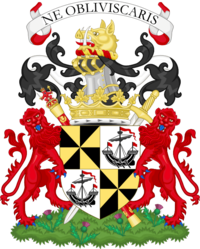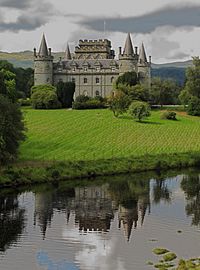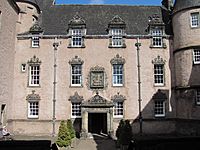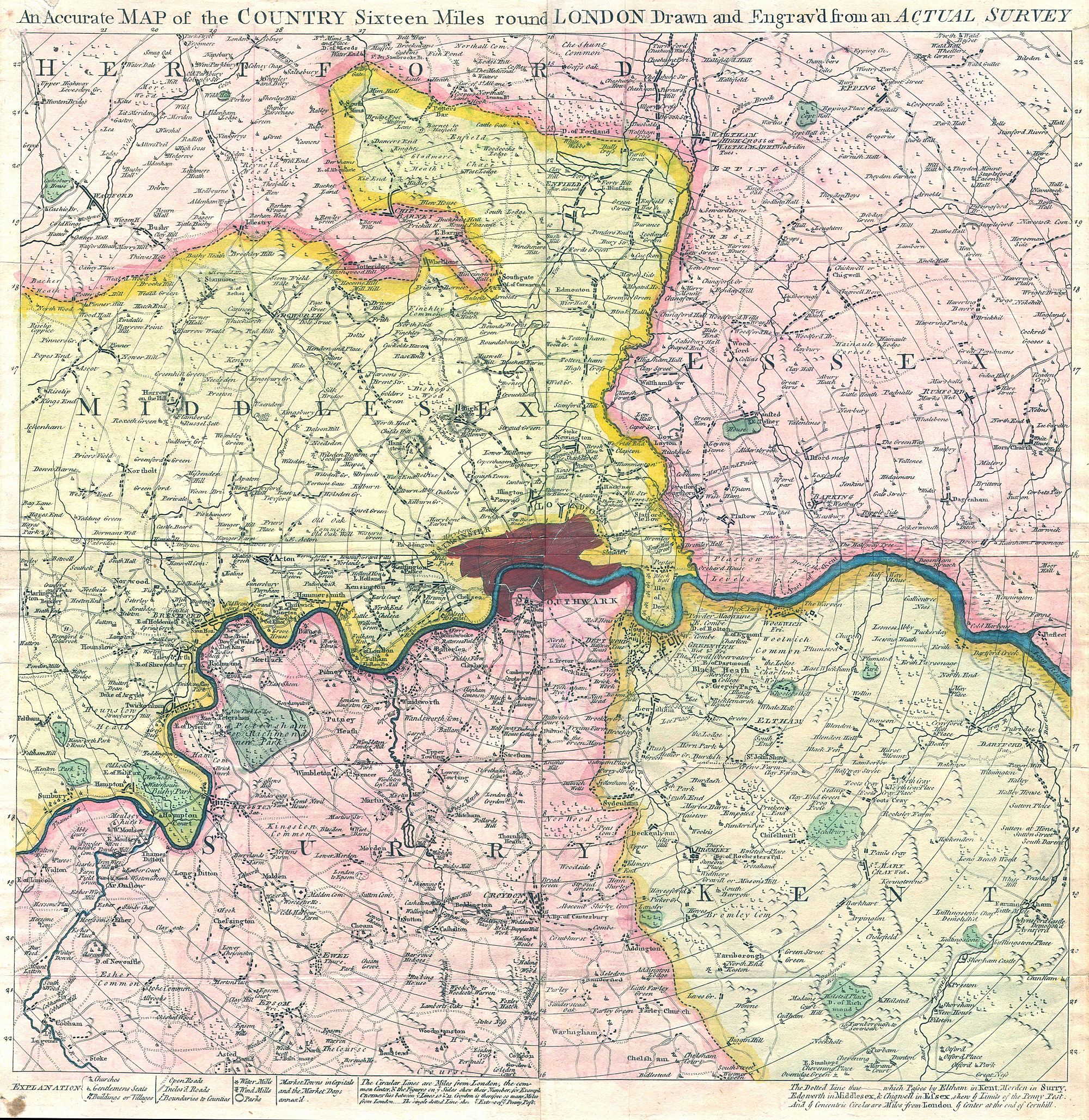Duke of Argyll facts for kids
Quick facts for kids Dukedom of Argyll |
|
|---|---|

Quarterly, 1st & 4th: Gyronny of eight or and sable (Campbell); 2nd & 3rd: Argent, a lymphad or ancient galley sails furled flags and pennants flying gules and oars in action sable (Lorne).
|
|
| Creation date | 21 June 1701 |
| Monarch | William of Orange |
| Peerage | Peerage of Scotland |
| First holder | Archibald Campbell, 10th Earl of Argyll |
| Present holder | Torquhil Campbell, 13th Duke |
| Heir apparent | Archie Campbell, Marquess of Lorne |
| Remainder to | the 1st Duke's heirs male whomsoever |
| Subsidiary titles | Marquess of Kintyre and Lorne Earl of Argyll Earl of Campbell and Cowal Viscount of Lochaw and Glenyla Lord Campbell Lord Lorne Lord Kintyre Lord Inveraray, Mull, Morvern, and Tiree Baron Sundridge Baron Hamilton |
| Seat(s) | Inveraray Castle |
| Former seat(s) | Argyll's Lodging Castle Campbell Ardencaple Castle |
The Duke of Argyll (Scottish Gaelic: Diùc Earraghàidheil) is a special title given to the head of the Campbell family in Scotland. This title was first created in 1701 in the Peerage of Scotland. Later, in 1892, another Duke of Argyll title was created in the Peerage of the United Kingdom.
For many centuries, the Earls, Marquesses, and Dukes of Argyll were very powerful noble families in Scotland. They played a huge part in Scottish history from the 1500s to the 1700s. The Duke of Argyll is also the traditional chief of Clan Campbell. Plus, they hold the important role of Master of the Household of Scotland.
Since 2001, Torquhil Campbell has been the Duke of Argyll. He is the thirteenth person to hold this important title.
Contents
History of the Dukes of Argyll
The story of the Dukes of Argyll began a long time ago. In 1280, a knight named Sir Colin Campbell of Lochow was honored. Later, in 1445, one of his family members, Sir Duncan Campbell, became the 1st Lord Campbell. This was the first step towards the Dukedom.

In 1457, Colin Campbell, who was the 2nd Lord Campbell, was given the title of Earl of Argyll. This made the family even more important.
The 8th Earl of Argyll became a Marquess in 1641. This happened when King Charles I visited Scotland. The Marquess became very powerful in Scotland during a time of big changes. However, he was later accused of treason and executed in 1661. His titles and lands were taken away.
But in 1663, his son, Archibald, got his family's titles back and became the 9th Earl of Argyll. Sadly, he was also executed in 1685 for his part in a rebellion.
On June 21, 1701, the 9th Earl's son was made the first Duke of Argyll. This was a reward for his help to King William of Orange. His son, the 2nd Duke, received more titles in England for supporting the Act of Union. When he died, his Scottish titles went to his brother, but his English titles ended.
The 5th Duke was a member of parliament. He later became a Baron, which allowed him to sit in the House of Lords.
On April 17, 1892, the 8th Duke was given another Duke of Argyll title. This one was in the Peerage of the United Kingdom. This means the Duke of Argyll is one of only a few people who hold two or more different Dukedom titles!
Around the late 1800s, a Duke of Argyll visited America. He stayed in a village called Babylon, New York. The people of the town really liked him. They even held festivals and parades! To remember his visit, the town renamed a lake and park to Argyle Lake/Park.
Family Homes and Burial Places
The main home of the Dukes of Argyll is Inveraray Castle. It is located next to Loch Fyne in Inveraray, Argyll. The estate is very large, covering about 75,000 acres. It includes forests, homes, and even places that make renewable energy.
Most Dukes and Duchesses of Argyll are buried at St Munn's Parish Church, Kilmun. However, the 11th and 12th Dukes chose to be buried on an island called Inishail in Loch Awe.
The family also had several homes in London over the years. One of these was called Argyll House. In 1764, the family also owned a house near London in a place called Ham.
Other Titles the Duke Holds
The Duke of Argyll holds many other titles in addition to his main Dukedom. These are called subsidiary titles. They include:
- Marquess of Kintyre and Lorne (created 1701)
- Earl of Argyll (created 1457)
- Earl Campbell and Cowall and Viscount Lochow and Glenyla (created 1701)
- Lord Campbell (created 1445)
- Lord Lorne (created 1470)
- Lord Kintyre (created 1626)
- Lord Inveraray, Mull, Mover and Tiry (created 1701)
- Baron Hamilton of Hameldon (created 1776)
- Baron Sundridge (created 1766)
Most of these titles are in the Peerage of Scotland. The last two, Baron Hamilton and Baron Sundridge, are in the Peerage of Great Britain. The Duke is also a Baronet of Lundie (created 1627).
The Duke's eldest son and heir is known by the courtesy title of Marquess of Lorne. This is a shorter version of his full courtesy title, Marquess of Kintyre and Lorne.
Special Family Roles
The Duke of Argyll also holds several important traditional roles, called hereditary offices. These roles have been passed down through the family for generations. They include:
- Hereditary Master of the Royal Household in Scotland: This means they have a special role in the Scottish Royal Household.
- Hereditary High Justiciar of Argyll: This was a very old legal role for the Argyll area.
- Admiral of the Western Coasts and Isles: A role related to the sea and islands.
- Hereditary Keeper of the Royal Castles of Carrick, Dunoon, Dunstaffnage, and Tarbert: They are the traditional guardians of these castles.
- Hereditary High Sheriff of Argyllshire: An old law enforcement role for the region.
- Member King's Body Guard for Scotland: They are part of the King's personal guard in Scotland.
The Duke of Argyll is also the chief of the Scottish Campbell clan. In this role, he is known as MacCailein Mòr. This is a Gaelic name meaning "The Great MacColin." It refers to an important ancestor named Cailean Mór (Colin the Great) who lived in the 1200s.
Since the time of King James IV, the Duke has also held the position of Master of the Household of Scotland.
Family Coat of Arms
A blazon is a special description of a coat of arms. The coat of arms for the Duke of Argyll has two main parts. The first and fourth sections show a pattern of eight gold and black triangles. This represents the Campbell family. The second and third sections show a silver background with a black ship that has its sails down and oars moving. It also has red flags flying. This part represents the Lorne family.
List of Dukes of Argyll
Here are the people who have held the title of Duke of Argyll:
Dukes of Argyll (1701)
- Archibald Campbell, 1st Duke of Argyll (1658–1703)
- John Campbell, 2nd Duke of Argyll, 1st Duke of Greenwich (1680–1743)
- Archibald Campbell, 3rd Duke of Argyll (1682–1761)
- John Campbell, 4th Duke of Argyll (1693–1770)
- John Campbell, 5th Duke of Argyll (1723–1806)
- George William Campbell, 6th Duke of Argyll (1768–1839)
- John Douglas Edward Henry Campbell, 7th Duke of Argyll (1777–1847)
- George John Douglas Campbell, 8th Duke of Argyll (1823–1900) (Also created Duke of Argyll in the Peerage of the United Kingdom in 1892)
- John George Edward Henry Douglas Sutherland Campbell, 9th Duke of Argyll (S) and 2nd Duke of Argyll (UK) (1845–1914)
- Niall Diarmid Campbell, 10th Duke of Argyll (S) and 3rd Duke of Argyll (UK) (1872–1949)
- Ian Douglas Campbell, 11th Duke of Argyll (S) and 4th Duke of Argyll (UK) (1903–1973)
- Ian Campbell, 12th Duke of Argyll (S) and 5th Duke of Argyll (UK) (1937–2001)
- Torquhil Ian Campbell, 13th Duke of Argyll (S) and 6th Duke of Argyll (UK) (born 1968)
The current Duke's eldest son, Archibald Frederick Campbell, Marquess of Lorne (born 2004), is next in line to inherit the title. He is known as Archie Lorne.
Current Line of Succession
 Ian Campbell, 11th Duke of Argyll (1903-1973)
Ian Campbell, 11th Duke of Argyll (1903-1973)
 Ian Campbell, 12th Duke of Argyll (1937-2001)
Ian Campbell, 12th Duke of Argyll (1937-2001)
 Torquhil Campbell, 13th Duke of Argyll (b. 1968)
Torquhil Campbell, 13th Duke of Argyll (b. 1968)
- (1) Archibald Friedrich Campbell, Marquess of Lorne (b. 2004), known as Archie Lorne
- (2) Lord Rory James Campbell (b. 2006)
- (3) Lord Colin Ivar Campbell (b. 1946)
See also
- Princess Louise, Duchess of Argyll (1848–1939), wife of the 9th Duke
- Earl Cawdor
- Clan Campbell
- Duke of Argyll's Tea Tree





